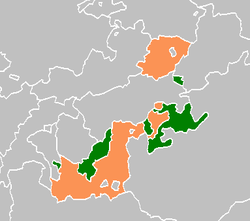House of Reuss
| Imperial County of Reuss | ||||||||||||
| Reichsgrafschaft Reuß | ||||||||||||
| State of the Holy Roman Empire | ||||||||||||
|
||||||||||||
|
Reuss in 1820: Elder (green) and Younger (orange) line
|
||||||||||||
| Capital | Weida until 1531, then Plauen, Gera and Greiz | |||||||||||
| Government | Principality | |||||||||||
| Historical era | Middle Ages | |||||||||||
| • | Established | ca 1010 | ||||||||||
| • | Partitioned to R.-Gera, R-Plauen and R-Weida |
ca 1206 |
||||||||||
| • | Partitioned into Elder, Middle and Younger line |
1564 |
||||||||||
| • | Principality of Reuss Elder Line |
1778 |
||||||||||
| • | Principality of Reuss Junior Line |
1806 | ||||||||||
|
||||||||||||
Reuss (German: Reuß) was the name of several historical states located in present-day Thuringia, Germany. Its rulers, the House of Reuss, named all of their male children Heinrich (English: Henry) after the end of the 12th century in honour of Henry VI, Holy Roman Emperor (1190–97), to whom they owed the estates of Weida and Gera. The head of each branch of the family bore the German title Fürst (Prince) as did their children.
Several different principalities of the House of Reuss which had previously existed had by the time of the formation of the German Confederation become part of the two remaining lines (the Elder and the Younger lines). Before then, they had been part first of the Holy Roman Empire, and then the Confederation of the Rhine.
The region including what would become the Principality of Reuss was inhabited in early medieval times by Slavic people who were converted to Christianity by the German Emperor Otto I (936–973). In church matters the region was under the Diocese of Zeitz (founded in 968), which became a suffragan of Magdeburg. On account of the frequent inroads of the Slavs, the residence of the Bishop of Zeitz was removed to Naumburg in 1028, after which the See was called Naumburg-Zeitz.
...
Wikipedia


